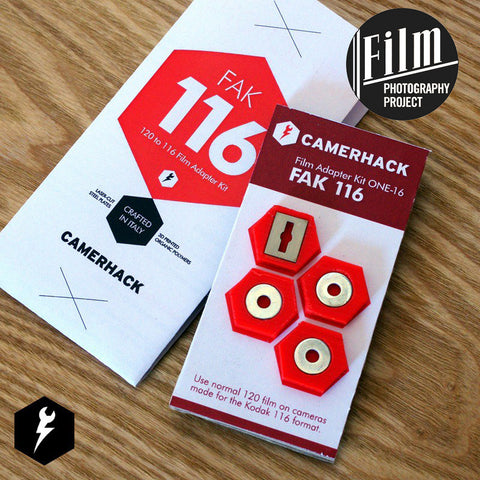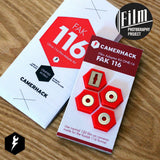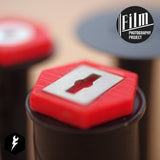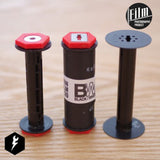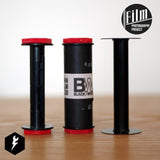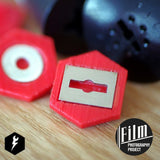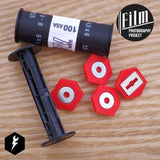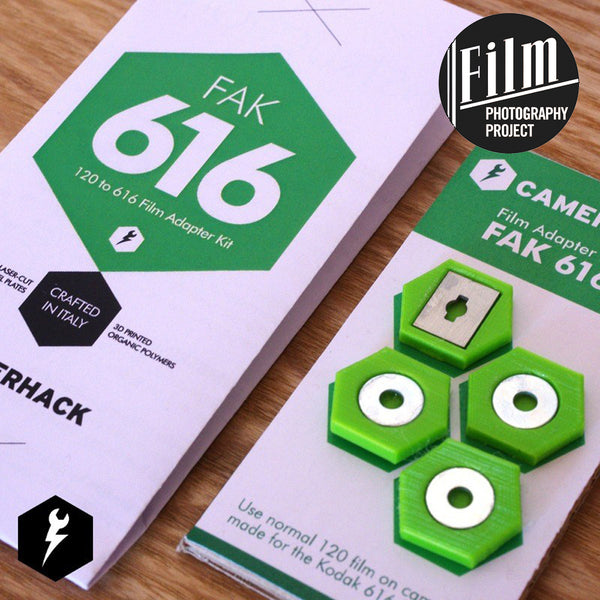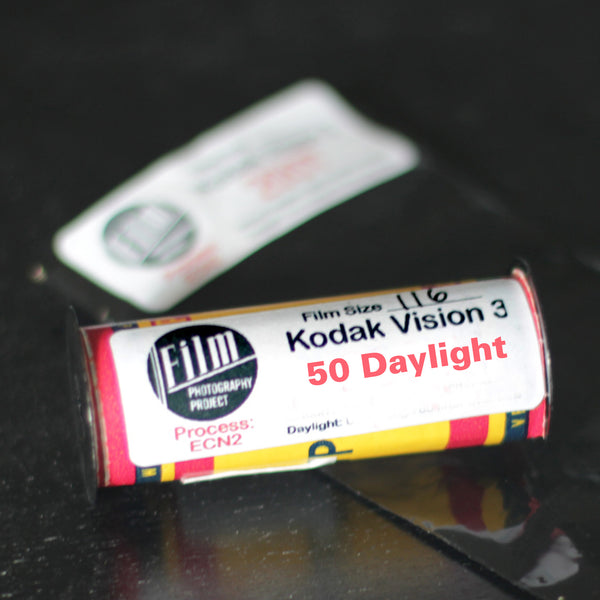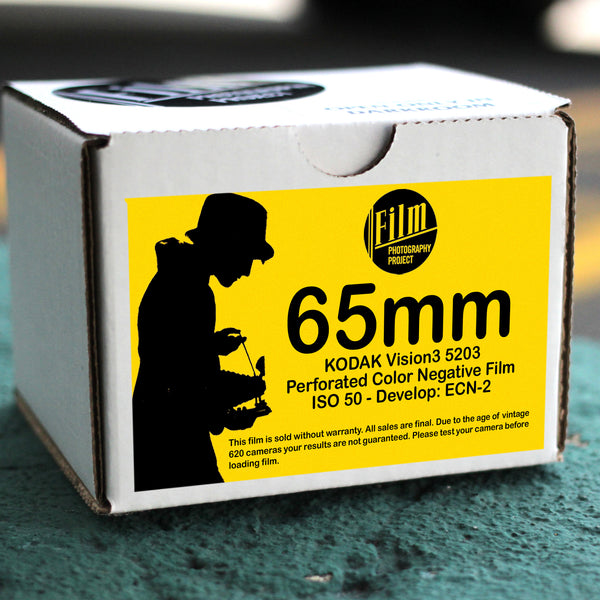Adapter - 116 to 120 Film Adapter
116 to 120 Film Adapter!
Load 120 film in your vintage Kodak (or other) 116 film camera!
Designed by CameraHack and imported from Italy! "Divertiti a scattare con la tua Kodak vintage"!
Includes:
- Four adapter pieces - Two for your 120 film and two for your take-up spool.
- One 120 take-up spool.
Adapters are very sturdy - do not force them or use the wrong end. We import this product from Italy, so adapters are not refundable and we will not replace adapters that you break.

The 116 Adapter is the Film Adapter Kit that let you load normal medium format 120 film in cameras made for the 116 film spools. We include a 120 take-up spool so there is no re-spooling involved. Simply apply the adapters, shoot and process!
With 120 film in a 116 film camera you’ll get 6 panoramic-format photographs with a size of about 11x6cm (4¼ x 2½ inches).
This adapter features a stainless steel flange that perfectly reproduce the same hole that’s in the original 116 spool flange. They are laser-cut out of a 1mm thick stainless steel plate.
The plastic parts are printed with a very solid PLA organic polymer, which is even stronger than the 120 spool material itself! Note that your adapter color will vary from the one pictured.

above: FPP guy Mike Raso with his vintage Kodak camera
Which 116 cameras?
The first camera using this film was the 1A Folding Pocket Kodak. Other 116 cameras: No.1A Autographic Kodak Junior, No.1A Pocket Kodak, No.1A Pocket Kodak Junior, No.1A Speed Kodak, No.2A Beau Brownie, No.2A Brownie, No.2A Folding Autographic Brownie, No.2A Folding Cartridge Hawkeye Model B, No.2A Folding Rainbow Hawk-Eye (Model B) and others.
Addition information direct from CamerHack - Italy
120 TO 116 FILM ADAPTER KIT
With FAK116 adapters mounted on the 120 spool, your camera will work exactly as it would with original 116 films.
No original 116 spool is needed for this system: you don’t have to respool the film from one spindle to another.
With the 120 film in a 116 film camera you’ll get 6 panoramic-format photographs with a size of about 11x6cm (4¼ x 2½ inches).
KIT COMPONENTS
The KIT comes with four adapters, two for each spool in the camera.
The kit also includes 4 white round extenders that are needed if your camera is BOX Brownie Camera or similar. In these cameras the spool has to be of a specific diameter for a perfect alignment of the film advance mechanism with the spool’s hole. To couple the exagonal adapters with its round extensions, press them hard through the hole until they are perfectly aligned on the flat end (i.e. where there’s the metal part).
The one adapter with a different hole is the “Key Adapter”: it features a 1mm laser-cut stainless steel flange that reproduces the same hole that’s in the original 116 spool. This adapter will engage with the camera’s film advance crank.
MOUNTING
- Load the the empty spool (take-up spool) with two adapters mounted at both ends, making sure that the Key Adaper corresponds to the camera’s film advance knob.
- Mount the other two adapters on the unexposed film and put it in the camera.
- Insert the paper leader into the take-up spool and roll up a little until it’s well inserted.
FRAME NUMBERING (NO RED WINDOW)
With the camera open, start winding the film until you see the big vertical arrow, then close your camera.
Turn the film advance knob 8 times (16 half turns) so that the film reaches the correct placing for the first photo.
After the first photo is taken, advance the film by 2,5 knob’s turns (or 5 half turns), and do this for photo 2, 3, 4, 5 and 6.
Then wind the film until the end: the empty spool becomes the take-up spool. Put the key adapter on it and go shoot again!
A little trial and error is to be expected.
FILM ADAPTER KIT 116 & COMPATIBLE CAMERAS
Load normal 120 film in ANY Kodak camera made for the 116 film:
— No. 1A Folding Pocket KODAK Camera (collapsing front) (1899 – 1905)
— No. 1A Folding Pocket KODAK Camera Model B (folding front) (1905 – 1906)
— No. 2A BROWNIE Camera (1907 – 1924)
— No. 1A Folding Pocket KODAK Camera Model C (wood lens mount) (1907 – 1909)
— No. 1A Folding Pocket KODAK Special Camera (1908 – 1912)
— No. 1A Speed KODAK Camera (1909 – 1913)
— No. 1A Folding Pocket KODAK Camera Model D (metal lens mount) (1909 – 1915)
— No. 1A Special KODAK Camera (1912- 1914)
— No. 1A Six-Three KODAK Camera (1913 – 1915)
— No. 1A KODAK Junior Camera (1914 – 1914)
— No. 1A Pocket KODAK Special Camera (1926 – 1934)
— No. 2A Folding Pocket BROWNIE Camera (1910 – 1915)
— No. 1A Folding Pocket KODAK-RR Type Camera (formerly listed as No. 1A Folding Pocket KODAK Special) (1912 – 1915)
— No. 1A AUTOGRAPHIC KODAK Junior Camera (1914 – 1927)
— No. 1A AUTOGRAPHIC KODAK Special Camera (1914 – 1916)
— No. 2A Folding AUTOGRAPHIC BROWNIE Camera (Changed from square to round ends in 1917) (1915 – 1926)
— No. 1A AUTOGRAPHIC KODAK 1917 Model Camera (1917 – 1924)
— No. 1A AUTOGRAPHIC KODAK Special Camera (w/coupled rangefinder and Bakelite side panels) (1917 – 1923)
— No. 1A AUTOGRAPHIC KODAK Special Camera w/coupled rangefinder, Model_B (Back overlaps sides) (1923 – 1926)
— No. 1A Pocket KODAK Series II Camera (1923 – 1931)
— No. 2A BROWNIE Camera (Aluminum, Model C) (1924 – 1933)
— No. 1A KODAK Series III Camera (1924 – 1931)
— No. 1A Pocket KODAK Camera (1926 – 1932)
— No. 1A Pocket KODAK Series II Camera (in 4 colors) (1928 – 1931)
— No. 1A Pocket KODAK Camera (In 4 colors: blue, brown, gray, green) (1929 – 1932)
— No. 1A Pocket KODAK Junior Camera (Black and 3 colors) (1929 – 1932)
— No. 2A BROWNIE Camera (5 colors) (1929 – 1933)
— No. 1A Gift KODAK Camera (packed in cedar box) (10,000 manufactured) (1930 – 1931)
— No. 2A Beau BROWNIE Camera (5 colors) (1930 – 1933)
Other makers’ cameras that accept 116 film will also work.
OPERATING CONDITIONS
If your camera has not been used for a long time, check that there is no rust, or dry grease, or dust, or dirt… The feed mechanism in cameras that were left unused for a long time could be very tight and cause a strong tension on the spools during the film advancement. Make sure that the mechanisms are properly lubricated before putting the camera back to work!
Enjoy shooting!

